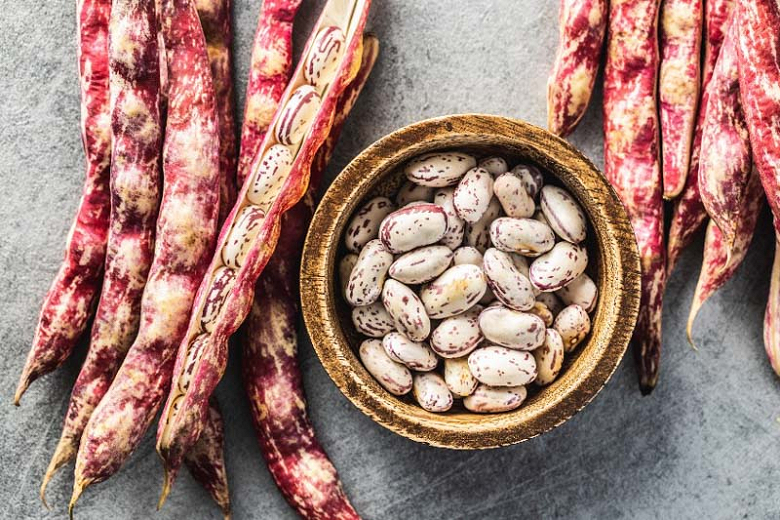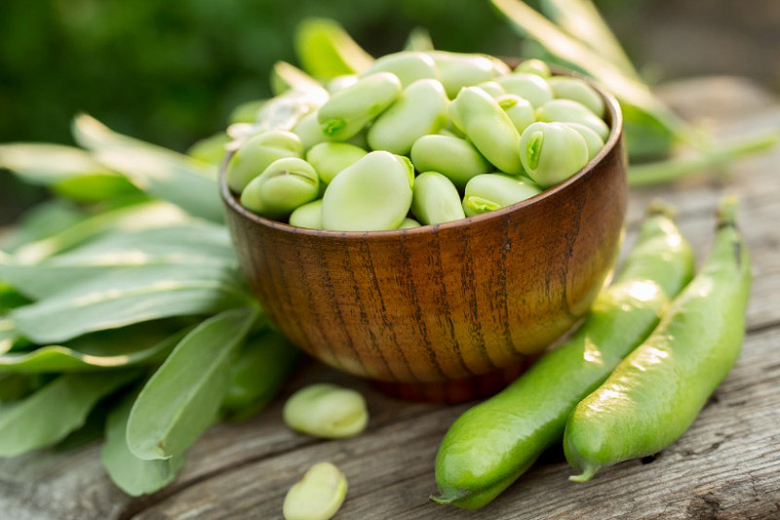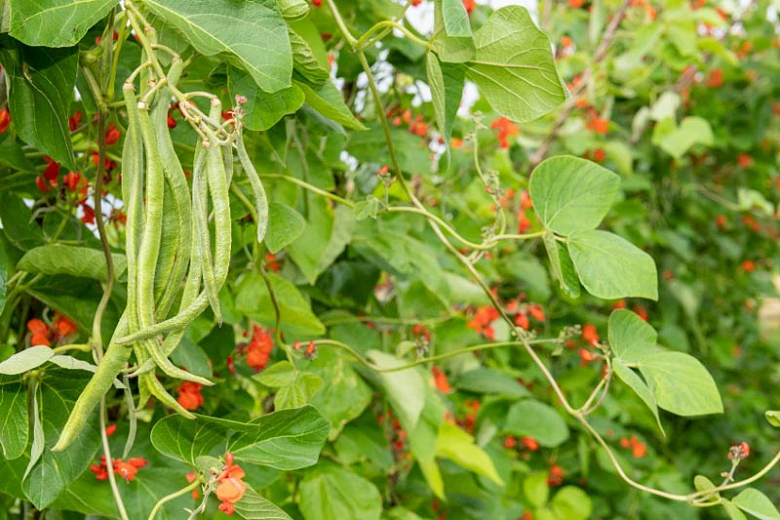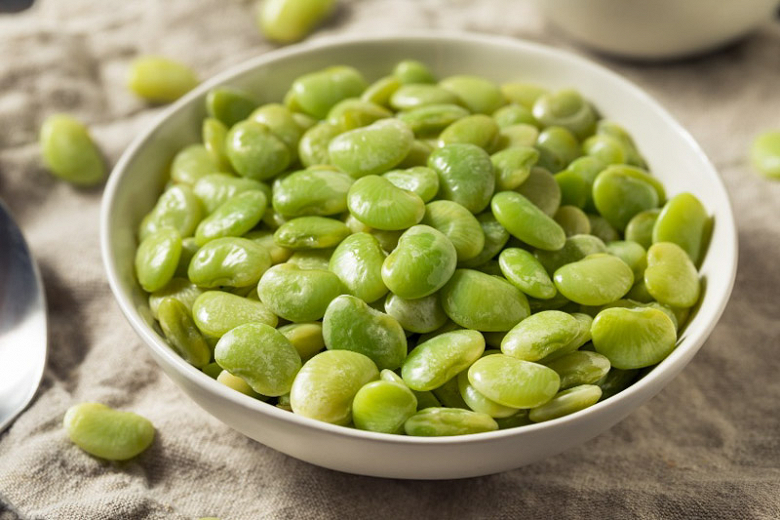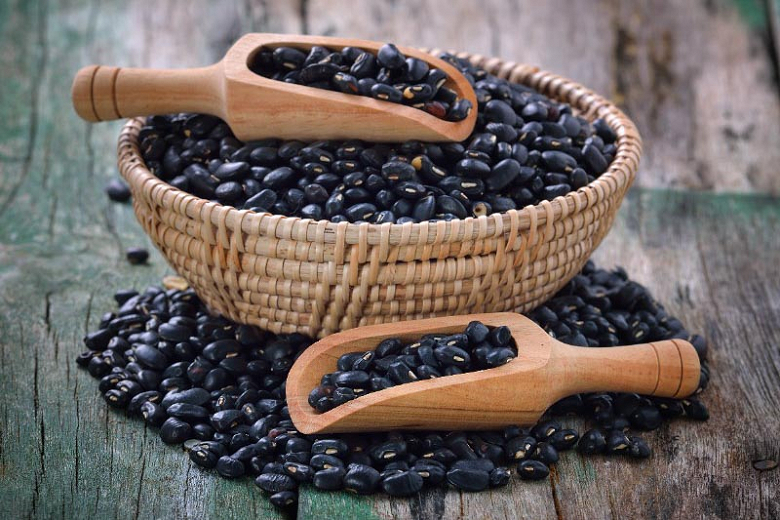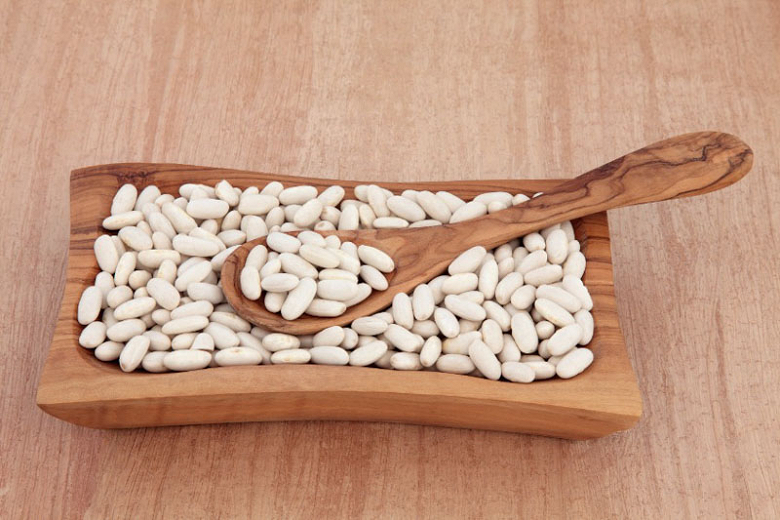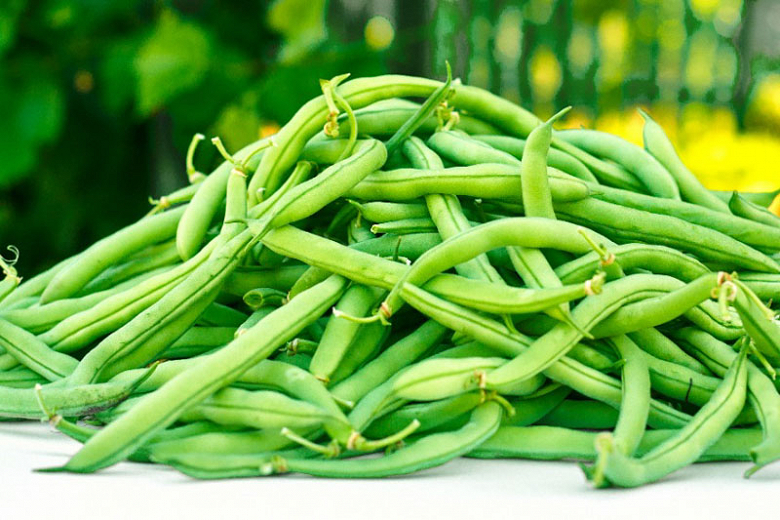Phaseolus vulgaris – Cranberry Beans
Creamy and flavorful, Cranberry beans, also known as Borlotti beans, are named for their brilliantly colored pods and pink-flecked beans. Pretty to look at, they are a great source of protein, fiber, and minerals that help support your health.
Creamy and flavorful, Cranberry beans, also known as Borlotti beans, are named for their brilliantly colored pods and pink-flecked beans. Pretty to look at, they are a great source of protein, fiber, and minerals that help support your health. Cranberry beans are a favorite in Italian and Portuguese cuisines. Although they look different from the green beans we are used to eating fresh, Cranberry beans belong to the same annual species, Phaseolus vulgaris.
What are Cranberry Beans?
- Cranberry beans belong to the plant family, Fabaceae, also known as the legume, pea, or bean family, which includes lentils, chickpeas, peas, and peanuts.
- Cranberry beans are believed to be native to South America and were introduced to Europe in the 15th century by Spanish explorers. Today they are cultivated worldwide.
- Also known as the Borlotti bean, the Cranberry bean has long been used in Italian cuisine.
- Like other bean varieties, Cranberry bean plants feature trailing green vines and trifoliate leaves with spade-shaped leaflets.
- They develop brilliantly colored but inedible pods. The slender and plump pods are pale yellow to cream with vibrant red, pink, and purple marbling and speckles.
- The pointed pods contain 5 to 6 oval ivory-white beans that are dappled with dark red-pink mottling.
- While Cranberry beans look like Pinto beans, they differ in flavor, being a little lighter and nuttier than Pinto beans.
- Cranberry beans are available in late summer and early fall. However, they are most commonly sold in their dried and canned form.
- Cranberry beans can be harvested fresh in the pod or left on the vine to dry.
- Cranberry beans can be grown at home in both bush and pole varieties.
- Cranberry beans fix nitrogen and add nutrients that improve the soil, benefitting the plants that are growing beside them. Beans are great for heavy nitrogen users.
- Popular Cranberry bean cultivars today include Vermont Cranberry, Crimson, and Tongues of Fire.
Cooking with Cranberry Beans
- Cranberry beans have a dense, starchy, and firm consistency. When cooked, they develop a tender, buttery, and creamy texture. Their flavor is mild, nutty, and subtly sweet, with chestnut-like nuances.
- Cranberry beans can be used as fresh-shelled beans (when young) or in their dried form.
- They are an excellent substitute for pinto beans, black beans, navy beans, or cannellini beans.
- Dried Cranberry beans must be soaked overnight before using and generally require twice the cooking time.
- Cranberry beans can be lightly boiled and added to salads, cooked, and pureed into dips, spreads, and sauces.
- They can also be cooked into pasta, added to main meat dishes, or served with roasted squashes as a savory vegetarian dish.
- Cranberry beans are one of the staple ingredients in the famous pasta and bean dish Pasta e Fagioli.
- Cranberry beans do not retain their distinctive markings once cooked. They turn into a tan to brown color.
Health Benefits of Cranberry Beans
- While Cranberry beans make a flavorful addition to various dishes, they can also provide health benefits.
- Cranberry beans are rich in protein and are considered a substantial meat substitute. These proteins benefit the immune system and help maintain healthy bones, hairs, organs, and muscles.
- Cranberry beans are also full of antioxidants, which help fight free radicals.
- Cranberry beans are loaded with fiber, which may help lower bad cholesterol levels and improve your heart health. Fiber also helps regulate the digestive tract and keep your digestive system healthy.
- They are also rich in carbohydrates and additionally contain folate, zinc, manganese, copper, calcium, and potassium.
- Cranberry beans provide a decent source of iron that can help prevent anemia.
- Nutrition Facts (per 100 grams): 140 calories, 24 grams carbs, 9 grams protein, 0 grams fat, 9 grams fiber.
How to Grow Cranberry Beans
- Cranberry beans grow up to 18-72 in. tall (45-180 cm), depending on the variety. They can be grown as a low bush (bush bean) or a vine climbing a trellis (pole bean).
- Cranberry beans perform best in fertile, acidic to neutral (pH ranging from 5.8 to 7.0), moist, well-drained soils in full sun (at least 6-8 hours of direct sunlight per day) in a sheltered location.
- If your soil lacks nutrients, add well-rotted organic matter or compost before planting.
- Keep the soil evenly moist but not soggy. Bean plants do require consistent and even moisture once they have formed flowers.
- Cranberry beans are a warm-weather crop and grow best between 65-85°F (18-29°C).
- Cranberry beans are sensitive to frost and will suffer damage from even a light frost. Cranberry beans perform poorly when temperatures rise above 85°F (29°C).
- Sow seeds outdoors anytime after the last spring frost date after the soil has warmed. At soil temperatures below 60°F (15°C), most bean cultivars germinate poorly and are more susceptible to pests and root rot.
- Do not start Cranberry bean seeds indoors because their roots are fragile and may not survive transplanting.
- Soak the seed in compost tea for 25 minutes before planting to help prevent disease and speed germination.
- Sow seed 1½ inches (4 cm), 4 to 6 inches (10-15 cm) apart with at least 2 feet (60 cm) between rows.
- Beans are soil builders. They rarely need any fertilizer during the growing season.
- Mulch to retain moisture, keep the soil cool, and control weeds.
- Rotate crops: Prevent problems by not planting beans in the same location more often than every 3 years.
- Compost plants after harvest. Cut them at the root. The nutrient-rich roots can be tilled back into the soil.
- Beans are susceptible to a few pests. Keep an eye out for aphids, blackflies, cucumber beetles, cutworms, grasshoppers, Japanese beetles, Mexican bean beetle, root-knot nematodes, slugs, snails, spider mites, Stinkbugs, thrips, whiteflies, and wireworms.
- Beans are susceptible to diseases, including anthracnose, bean mosaic virus, powdery mildew, bean root rot, bean rust, and white mold.
When to Harvest Cranberry Beans
- Depending on the variety, Cranberry beans take 75-90 days to harvest after planting.
- Cranberry bush beans mature all at once, but pole beans are harvested on a continuous basis which encourages additional production for a month or two.
- Cranberry beans are ready for picking when the bean pods have turned brown and dried out .
- Harvest Cranberry beans by cutting the pods using clean scissors or a pruning shear.
- After you pick the dried pods from the plants, shell them and remove the Cranberry beans from inside them.
- Fresh, unshelled beans will keep 3 to 4 days when stored in a plastic bag in the refrigerator. Dried beans will keep up to one year when stored in a container in a cool, dry, and dark location.
- Cranberry beans can also be pickled, canned, or frozen for future use.
Best and Worst Companion Plants for Beans
- Beans are great for heavy nitrogen users. They add nutrients and improve the soil, benefitting the plants that are growing beside them.
- A good example of companion planting is The Three Sisters Garden. Practiced by Native Americans thousands of years ago, this garden includes corn, beans, and squash. The tall corn provides shade for the lower squash but also stops the squash vine borer beetle. Corn also provides support for the bean plants to climb up. The beans enrich the soil with nutrients for both corn and squash. And the large leaves of the squash vines create a protective mulch that helps retain moisture while suppressing weeds. Another added benefit is the prickly vines of the squash deter the raccoons from stripping the corncobs.
- Mexican bean beetles can reduce the production of green beans if allowed to multiply. Their damage is reduced spectacularly when beans are interplanted with other vegetables and herbs.
- Cranberry beans can be grown at home in both determinate (bush) and indeterminate (pole) varieties.
Best and Worst Companion Plants for Bush Beans
Best and Worst Companion Plants for Pole Beans
Requirements
| Hardiness | 2 – 11 |
|---|---|
| Climate Zones | 1, 1A, 1B, 2, 2A, 2B, 3, 3A, 3B, 4, 5, 6, 7, 8, 9, 10, 11, 12, 13, 14, 15, 16, 17, 18, 19, 20, 21, 22, 23, 24, A1, A2, A3, H1, H2 |
| Plant Type | Annuals, Fruit |
| Plant Family | Phaseolus – Beans |
| Exposure | Full Sun |
| Season of Interest | Summer (Late)Fall |
| Height | 1' – 6' (30cm – 180cm) |
| Spread | 1' – 2' (30cm – 60cm) |
| Water Needs | Average |
| Maintenance | Average |
| Soil Type | Chalk, Clay, Loam, Sand |
| Soil pH | Acid, Alkaline, Neutral |
| Soil Drainage | Moist but Well-Drained |
